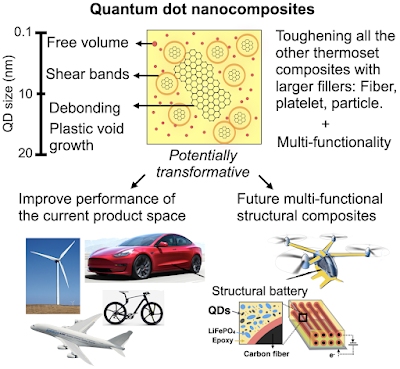
New grant NSF CAREER: Multi-scale Mechanical Behavior of Quantum Dot Nanocomposites: Towards Data-driven Automatic Discovery of High-performance Structures
- Post by: siteadmin
- March 12, 2022
- Comments off
I will be working on the mechanics of quantum dot nanocomposites. Thanks for all the support from NSF, reviewers, and officers Dr. Nakhiah Goulbourne and Dr. Siddiq Qidwai. More information coming soon.
ABSTRACT
This Faculty Early Career Development (CAREER) grant will support fundamental research on processing-structure-mechanics relationships in thermosetting nanocomposites containing ultrasmall two-dimensional quantum dot nanoparticles. Thermosetting polymers are used by aerospace, defense, transportation, electronics, and many other industries. Moreover, fiber reinforced thermoset composites dominate high-performance structural applications. Despite their common use, thermosets are brittle. Quantum dot nanoparticles, on the other hand, simultaneously enhance the toughness and strength of the thermosets. Yet, we don’t know how the ultrasmall two-dimensional particles enhance mechanical properties of the thermosets. The researched project will reveal the molecular origins of these enhancements using systematic simulations and experiments. This new knowledge is potentially transformative because quantum dots can enhance all the other larger-scale-filler composites, such as continuous fiber, graphene, and carbon nanotube composites. The education objective is to create open-source virtual reality engineering education tools and cultivate creative engineers. Unique collaborative design projects are planned to enhance student creativity that can impact innovation potential of the next-generation engineers. Outreach activities will also be performed in the elementary/high schools that serve underrepresented groups in the Silicon Valley.
This study will improve our understanding of molecular level damage/deformation mechanisms as well as macroscopic fracture behavior of quantum dot nanocomposites. A specific focus is given to unique sub-20 nm structures containing up to three different quantum dot sizes that can react with thermosets and with each other. During this CAREER award, a combination of experimental, theoretical, computational, and informatics approaches will be used to answer: (a) How do quantum dot nanocomposites deform and break? (b) What are their main toughening mechanisms? The research objectives are to (i) reveal the load transfer and debonding mechanisms, (ii) identify the plastic deformation, damage initiation, and damage accumulation mechanisms, and (iii) observe, quantify, and model the toughening mechanisms in thermosets containing multi-modal size quantum dots below 20 nm. To achieve these objectives, molecular dynamics synthesis and mechanical tests will be performed. Positron annihilation time spectroscopy, in-situ Raman spectroscopy, in-situ synchrotron X-ray characterization, and ex-situ mechanical tests will be performed. A molecular dynamics-informed multi-scale model will be used to quantify the toughening behavior. In addition, a new atomistic data-driven predictive framework will be created to quickly discover nanocomposites with high mechanical performance.
https://www.nsf.gov/awardsearch/showAward?AWD_ID=2145604&HistoricalAwards=false
Posted 12th March 2022 by Ozgur Keles